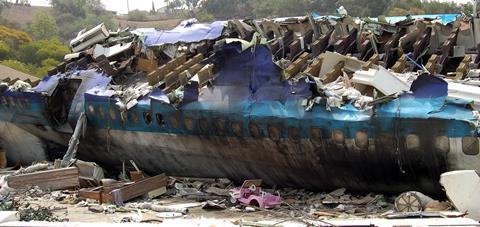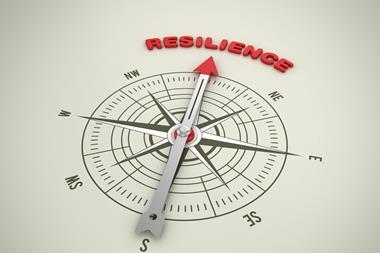Investigations are on-going as to what caused the disaster but what has ensued so far are a range of crisis risks, from reputational damage to share price loss. Risk managers offer their views on how they would lessen the impact

The impact for business travel management
Risk managers for companies that send employees abroad need to critically examine their business travel risk management in light of the Boeing crashes, says Elain Heyworth, Head of Risk Management and Insurance for Ofcom.
She explains: “First of all, I would expect all risk managers to ensure that their travel insurance was fit for purpose - for example, while I don’t have people who travel to Africa or the Middle East these days, in the past I did, and had to ensure that we had comprehensive cover for any type of accidents/incidents.
“That being said, you never work on the possibility of a plane crash when you’re buying your insurance - that would be a risk too far! We always ensured that we booked our employees on reliable airlines but if they were travelling in usual parts of the world, we would also check the aircraft being used. Given that these airplanes were relatively new, I suspect if I had an employee using one, I wouldn’t have worried too much about them.”
“One of the rules I have instigated at my places of work was that no more than five senior executives could travel on the same plane or train at any one time. This could be quite problematic if we had a large gathering somewhere, but there were usually plenty of alternatives, and it was a rule we enforced very strictly. Losing any more than five of your senior team could be catastrophic for a business.”
“Risk Managers should be managing the crisis management processes, and HR will be involved in ensuring that the business has all the necessary ‘next of kin’ information.
“During this kind of tragedy, it will often be through a business that people are identified, and the business needs to be able to follow up with family if necessary.
“The crisis management team needs to get together to ensure that employees are informed appropriately if you have lost a member of staff due to this type of incident.
“Families may need support and assistance, and could very well look to the business to help them in these difficult circumstances. A person should be nominated as a liaison officer with the family, so they only have to speak to one person every time - to help minimise the confusion of the situation. “If you have death in service cover, then find out the details. They may not want to talk about that immediately, but a family in crisis will suddenly realise they have no more funds coming in, so a little reassurance could be very helpful.
“If a business loses someone very senior, they may also need to think about announcements to the Stock Exchange, so the crisis management plan should have some kind of holding PR statement, that can be released publicly, giving everyone a little breathing space to work out what happens next.
“When it comes to risk mitigation, that’s a tough one. If you expect every plane your executives fly on to fall out of the sky, then you’d never send them anywhere. But you can have your crisis management plans to hand, with people capable of running a crisis on behalf of your business. If you think about it, this is also where your succession planning steps up - if you are already considering who might be a successor, you have someone who can hold your business together.
“One of my most useful techniques for dealing with these types of emergencies is scenario planning. Get the executive team in a room, and map the scenario. Pick someone who could be the person lost, and try to work out how you would manage without them. It can be a very interesting exercise.”
In March this year, Ethiopian Airlines Flight 302 crashed shortly after take-off, killing 157 passengers and crew.
Just five months earlier, another Boeing 737 Max crashed in Indonesia, claiming the lives of a further 189 people.
The human cost of these disasters has been huge. In response, regulators across the world have banned the aircraft from using airports or airspace.
Restriction has been implemented in at least 50 countries including the UK, the EU, China and the United States.
An explanation of why the planes crashed has been slow to emerge, but initial investigations suggest a software issue caused the planes to nosedive. Investigations are continuing and it will be some time until we have a full picture.
The material cost of these disasters will also be incredibly high. Boeing has announced that it is temporarily reducing production of its planes while it scrambles to deal with the technical faults.
Boeing’s chief executive officer Dennis Muilenburg said in a statement: “We now know that the recent Lion Air Flight 610 and Ethiopian Airlines Flight 302 accidents were caused by a chain of events, with a common chain link being erroneous activation of the aircraft’s MCAS function. We have the responsibility to eliminate this risk, and we know how to do it.
“As we continue to work through these steps, we’re adjusting the 737 production system temporarily to accommodate the pause in Max deliveries, allowing us to prioritise additional resources to focus on software certification and returning the Max to flight.”
Boeing’s share price has suffered substantial hits. It fell 13% in the immediate aftermath of the Ethiopian crash and fell another per cent following the announcement about delayed production.
The airlines involved will also be making substantial insurance claims. A well-placed source told StrategicRISK’s sister title, Insurance Times, that the price of the near-new plane alone would be approximately $110m (£82m), and likely to have been insured for $130-$150m
”It’s early days on the liabilities, and it will depend on the ticketing, nationalities etc., if its a million [US dollars] a head that’s $157m, if its 2 million a head it would be $315m, its far too early to say.”
Willis Towers Watson is the broker for Ethiopian Airlines and Chubb was the lead underwriter, but neither company is commenting on the situation at this time.
Learning from disaster - preparation
While we are still some way off fully understanding the causes and the costs of these crashes, there still lessons to be learnt.
These incidents demonstrate the importance of disaster planning. Airlines are highly regulated, and they go to great lengths to ensure that planes don’t crash, but clearly the worst can still happen.
Hans Læssøe, principal consultant at AKTUS and former risk manager at The Lego Group says: “The first lesson has to be that no matter how diligent you are, you can get affected by incidents, which are outside your control. This is not the same as saying the incident can be seen as unexpected – crashes have to be on the risk agenda of airlines.
“Airlines work with aircraft manufacturers and authorities to minimise the risk for a crash ever happening (cynically – if for no other reason than it is bad business) – but this does not mean they cannot or will not happen ever… A responsible airline must have an emergency plan ready and trained and documented for such event – irrespective of why it actually happened.”
Even those outside the aerospace industry can learn from this. Most big businesses plan for risks that are within their control, but it’s imperative to look at eventualities that a company may not be able to prevent but which could still have severe repercussions. This could be anything from a software fault that causes a crash, to incidents arising from acts of terrorism, nat cats, or suppliers making critical or dangerous errors.
Vincent Feys, a crisis management specialist at NYA ,has extensive experience in the aerospace industry and has worked with some of the industry’s leading organisations. He argues that a properly prepared plan needs to embrace both crisis management capabilities and business continuity capabilities into a broader resilience building program.
He says: “Crisis management will look into the ability of the company to effectively respond to the crisis situation, whether on broader communication aspects, victims and family liaison, flight operations, and global co-ordination with all involved stakeholders such as authorities or aircraft manufacturers.
“Business continuity will look at how is the company is effectively able to maintain an acceptable level of service operations (flying passengers all over the world) while suffering from severe impacts such as airport closures or aircraft groundings.”
From an airline’s perspective he says that things to consider include:
- Being able to communicate in a matter of minutes, at least to acknowledge an incident/accident has happened.
- The ability to activate your Crisis Management Team and Crisis Communication Team in a matter of minutes, on a 24/7 basis.
- Being able to work together with airports, Authorities (First Responders and Civil Aviation Authorities) and the aircraft manufacturer (work out a stakeholder mapping ahead of an incident is critical)
- Having a plan to work out, confirm and communicate your PAX list to Authorities (the airline may be the only source of information vital to other parties
- Setting up a Family Care Assistance Team – make sure victim’s relatives and next of kin are looked after.
While this checklist is specific to aerospace disasters, clearly any business can and should have a similar plan to help manage a crisis.
Dealing with the media
A substantial part of this plan – particularly when a crisis leads to loss of human life – needs a clear media and communications strategy.
When a disaster strikes, companies will face substantial questions over what happened, what the causes were, and what it intends to do next.
And when this goes badly, it can rock a business’ share price and frequently leads to senior executives losing their jobs,
Carl Leeman, chief risk officer at Katoen Natie explains: “In any case where you have such a large amount of fatalities, the first thing to worry about is casualties and families.
“It’s stupid to speculate on the causes of an incident - that’s not up to you. You can say that an investigation has started but the first thoughts go to families of victims and we will do whatever we can to help them.”
He says that often one of the biggest challenges is the battle between PR and legal advisers, who may often have very different views on what needs to happen next. To counter this, it is ideal to get your various advisers and other relevant staff in a room together to work out next steps and appropriate response. But Leeman says that achieving this can be difficult, particularly if you do not have a response strategy developed before a crisis hits.
He says: “Getting the balance between legal and PR departments is one of the most challenging things. It’s useful to have both in the same room because if they can challenge each other that’s better than you just getting two completely different sets of advice. Having the names of who should be called, that’s the first important step to have. If you don’t have the names and have to look for them it’s a lost game.”
It’s also critical to have a clear idea of who can speak to the press. Ideally this should be one person, who speaks the native language. If you must have more than one spokesperson, you need to make sure that there is one clear message that everyone is sticking to.
Media training is also imperative here. Anyone who is likely to need to speak to journalists after an incident involving loss of life, must have extensive training on how to deal with this.
Læssøe agrees. He says: “A disaster or major accident like this one has immediate consequences, and calls for immediate, yet controlled action. Speed and accuracy is pivotal for an emergency plan to work.”
He argues that businesses need a clearly defined, documented and well-trained disaster plan describing exactly:
- Who is in charge – this will not be the CEO, but a trained specialist who’s authority is not challenged (we do not have time for consensus or corporate policy)
- Who does what – and who (everybody else) keeps out of the way
- How does information flow to where – what to tell and to whom
- Who begins to look at and plan how to operate the rest of the company during and after the immediate emergency is over.
When a company handles the media well, it can lead to good outcomes. Indeed, Ethiopian Airlines media policy has already helped the company navigate the crisis well, according to Læssøe.
He says: “Look at Ethiopian Airlines who suddenly had their excellent safety track record and standard expressed in media world-wide – a status which may not have been recognised for any African airline by arrogant Europeans and/or Americans. There is little doubt this will support their ongoing business.”
Dealing with social media
As well as managing traditional media, companies need to be prepared for the challenges that come with social media.
In this day an age everyone with access to a computer or a smartphone can have an audience, and it’s easy for a story – even one with no basis in fact – to get out of control.
Leeman says: “The most difficult to handle is the social media, people get emotional say stupid things. Often they don’t know the whole picture but have an idea and then write whatever they want. That’s not at all easy to handle. You need to have people following to see whether you need to react. Sometimes if you give correct information the debate stops but sometimes it starts its own life.
Feys agrees that social media has fundamentally changed the way that businesses need to react in a crisis. This means that risk managers need to understand the challenges and come up with a plan to deal with the immediacy of the new tech world.
He says: “The first tweet after an aircraft accident will be sent out in a matter of seconds after the crash. Social media needs to be an integral part of any crisis management plan for an airline. There is no longer the luxury to respond in two hours, or even twenty minutes.”




















No comments yet